|

Autumn 2001 (9.3)
Pages
40-49
Writing Azerbaijan's
History
Digging
for the Truth
by
Farid Alakbarov
Photos: Archives of Baku's Institute of Manuscripts
  In terms of remembering
their own history, Azerbaijanis are suffering from a collective
case of amnesia - but much of it really isn't their own fault.
Throughout 70 years of Soviet rule, Azerbaijani history was twisted
and manipulated to suit the needs of the Communist regime. Today
it is extremely frustrating and difficult to track down even
basic information related to specific names, dates or figures
- especially if
they relate to pre-Soviet eras like the turn-of-the-century Oil
Boom and Azerbaijan's brief period of independence (1918-1920) In terms of remembering
their own history, Azerbaijanis are suffering from a collective
case of amnesia - but much of it really isn't their own fault.
Throughout 70 years of Soviet rule, Azerbaijani history was twisted
and manipulated to suit the needs of the Communist regime. Today
it is extremely frustrating and difficult to track down even
basic information related to specific names, dates or figures
- especially if
they relate to pre-Soviet eras like the turn-of-the-century Oil
Boom and Azerbaijan's brief period of independence (1918-1920)
Even earlier eras have been completely distorted.
I believe that someday a comprehensive,
objective, non-ideological history of Azerbaijan will be written,
but not today. It will take time to cultivate a culture of calm,
rational scientific debate. Science must be free of ideology.
Azerbaijani historians are now sorting through the confusion,
working to unravel the threads and clues deliberately squelched
by "historians" of the Soviet era. Here Farid Alakbarov
leads us through the specifics of how Azerbaijani history is
being rewritten, now that it no longer has to be viewed through
the lens of Soviet ideology.
The history
of Azerbaijan has been written and rewritten numerous times
- both before and
after Azerbaijan gained its independence in late 1991. In every
case, this process of reconstructing the past has been influenced,
or even dictated, by political ideology.
 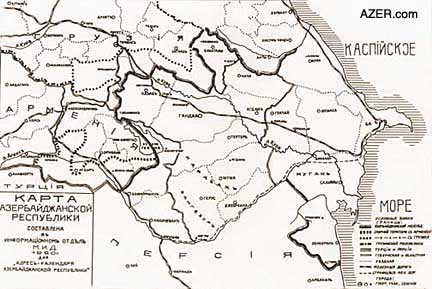
Above:
The map
of ADR (Azerbaijan Democratic Republic) issued in Russian in
1920 by Ministry of Foreign Affairs of ADR. During the Soviet
period, this map was hidden in secret archives, so Azerbaijani
historians were not able to learn about the territorial boundaries
of ADR (1918-1920). After independence in 1991, Azerbaijan's
Ministry of Foreign Affairs published this map.
 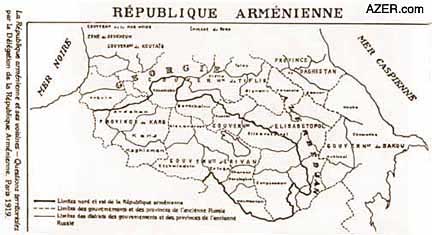
Above: The map of the Republic
of Armenia issued in Paris in1919. Note that it reflects the
wishful thinking for territorial claims of Armenia and includes
such Azerbaijani territories as Karabakh, Nakhchivan, and Zangazur
(territory given to Armenia by Stalin in 1920s that separates
mainland Azerbaijan from Nakhchivan); the Georgian provinces
of Akhalkalak and Borchali; and the Turkish provinces of Kars.
Armenians fought with Azerbaijan, Georgia and Turkey during this
period (1918-1920) in an attempt to capture these territories
but they did not succeed. Historical documents in all of these
countries, including Armenia, indicate that Armenia never controlled
these territories at this time.
When the Bolsheviks took over Baku in April 1920, they succeeded
in carrying out what Azerbaijan had failed to do during the Tsarist
Russia (early-19th century to 1918) period and the Azerbaijan
Democratic Republic (ADR) period, which lasted for a brief 23
months between May 28, 1918 and April 28, 1920.
The Bolsheviks encouraged the study of history. They opened numerous
schools and universities where history was taught and established
many academic institutions for carrying out historical research.
However, all books and articles had to be written from the ideological
position of the so-called "working-class point-of-view"
based on Marxist-Leninist theory. At best, Soviet historical
works were a mixture of true facts wrongly interpreted. At worst,
even well-known historical facts were obscured, denied or distorted.
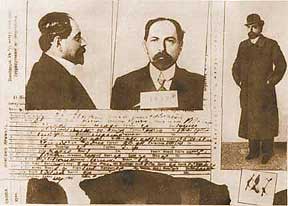  Left: The police record of Narimanov at the
Gendarme Department of Tiflis (Tbilisi), where he was arrested
as a Bolshevik in 1909. Narimanov became the future Chairman
of the Central Executive Committee of the Russian Communist Party.
Such photos were rarely published in Soviet historical books.
Rather, Bolsheviks were depicted as martyrs and innocent victims
of the Czar's regime. Left: The police record of Narimanov at the
Gendarme Department of Tiflis (Tbilisi), where he was arrested
as a Bolshevik in 1909. Narimanov became the future Chairman
of the Central Executive Committee of the Russian Communist Party.
Such photos were rarely published in Soviet historical books.
Rather, Bolsheviks were depicted as martyrs and innocent victims
of the Czar's regime.
Soviet
historians had the tendency to describe the negative sides of
the rich and the positive sides of the poor. Kings were identified
as tyrants. Poor people were pawns exploited by the rich.
Since the collapse of the Soviet Union in 1991, when Azerbaijan
gained its independence, much of Azerbaijan's history has been
revised. Historians have been poring over the documents that
were preserved in numerous archives. For example, the Institute
of Manuscripts of the Azerbaijan Academy of Sciences, where I
work, has one of the country's richest historical collections.
It houses manuscripts from medieval historians from as far back
as the 10th century, edicts signed by Azerbaijani khans in the
18th century, letters and notebooks by Azerbaijani intellectuals
of the 19th and 20th centuries, newspapers and magazines issued
100 years ago, and decrees of the fledgling government of the
Azerbaijan Democratic Republic. Analysis of these sources is
helping today's historians write a more objective history of
Azerbaijan.
History of Azerbaijan
Soviet-era Azerbaijani history books are only of limited use
to us today. One familiar work, the "History of Azerbaijan",
is an apt example of a flawed, Soviet-authorized version of Azerbaijani
history. This volume, prepared by the Azerbaijan Academy of Sciences,
was first published in the 1950s and then again in the 1960s.
Many historians, including Huseynov, Tokarzhevski, Aliyev and
Sumbatzade, participated in the major effort that went into preparing
this book. It was the first of its kind: a serious academic and
official history of Azerbaijan.
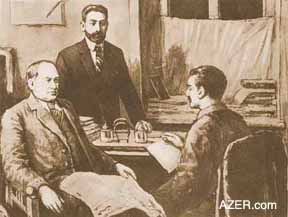  Above: A painting of Azerbaijani
Bolsheviks Narimanov, Azizbeyov and Afandiyev in an "Hummat"
editorial (artist T. Taghizade). Such paintings were a type of
Soviet propaganda meant to glorify and idealize famous Bolsheviks. Above: A painting of Azerbaijani
Bolsheviks Narimanov, Azizbeyov and Afandiyev in an "Hummat"
editorial (artist T. Taghizade). Such paintings were a type of
Soviet propaganda meant to glorify and idealize famous Bolsheviks.
The first edition of "History of Azerbaijan" consisted
of a single volume (really more of an outline); the second edition
included three volumes. The first of these volumes covered ancient
and medieval Azerbaijani history up until Azerbaijan was absorbed
by the Russian Empire in the early 19th century.
The second volume took the reader from the Russian colonization
period up to the beginning of the 20th century. The final volume
covered 20th-century history, including the Bolshevik Revolution,
World War II and the building of socialism in Azerbaijan.
These books were published in both Azeri and Russian - that is, there were
two identical versions in the two languages. "History of
Azerbaijan" was written for a wide range of readers, not
just for academics. The book was taught in high schools, university
history departments and pedagogical institutes.
One useful aspect of this book was that, for the first time,
Azerbaijanis were described as a separate nation with their own
country, language and history. They were not considered part
of the Persian people, part of the Turkish (Osmanli) nation or
as Tatars of Russia. This book described the Azerbaijani people
as having their own state in this territory as far back as the
9th century BC.
Iran and Turkey
Of course, "History of Azerbaijan" had many shortcomings,
since it was written from the Communist ideological position.
All historical processes were analyzed on the basis of Marxist-Leninist
theory. For instance, during the Soviet period, Turkey and Iran
were considered to be historical enemies of Azerbaijan. Therefore,
"History of Azerbaijan" includes statements such as:
"In the 17th century, Turkish troops completely destroyed
and devastated Tabriz and other places of Azerbaijan... In this
period Azerbaijan turned into a military theater of bloody wars
between Iran and Turkey...Thousands of people were killed and
turned into slaves...Azerbaijani people suffered very much!"
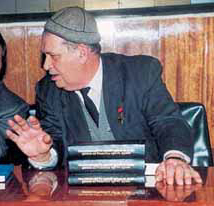  Left: Late Ziya Bunyadov, Historian, Orientalist
and Vice President of Azerbaijan's Academy of Sciences, on the
occasion of LUKoil's publishing of Bunyadov's translation of
the medieval manuscripts of Jalal al Din Mankburna, last Sultan
of the Dynasty of Anushtegenids. Bunyadov, a controversial figure
because of his historical research and a member of Parliament,
was mysteriously murdered in 1997. He is buried in Baku's "Fakri
Khiyabani" (Cemetery of the Honored Ones). Photo: 1996. Left: Late Ziya Bunyadov, Historian, Orientalist
and Vice President of Azerbaijan's Academy of Sciences, on the
occasion of LUKoil's publishing of Bunyadov's translation of
the medieval manuscripts of Jalal al Din Mankburna, last Sultan
of the Dynasty of Anushtegenids. Bunyadov, a controversial figure
because of his historical research and a member of Parliament,
was mysteriously murdered in 1997. He is buried in Baku's "Fakri
Khiyabani" (Cemetery of the Honored Ones). Photo: 1996.
All
wars are bloody. But what conclusion did the Soviet ideologists
draw? "So, both Iran and Turkey are your enemies!"
Many Azerbaijani readers did not agree with this idea. They knew
that many countries of the world had fought against each other
at various times. For instance, consider the various European
countries that fought against each other in the past century
but are not enemies today.
Besides, in the medieval period, wars were fought between dynasties,
shahs and sultans -
not between nations. Russia itself invaded Azerbaijan in the
18th century, and General Zubov killed hundreds of civilians
in Baku. "Why aren't the Russians considered our enemies?"
many Azerbaijanis wondered.
Describing Turkey as anything other than an enemy was dangerous
for Soviet-era historians, who were afraid of being labeled as
"Pan-Turkists". Soviet propagandists branded some poets
and intellectuals from the late 19th century and early 20th century
as "Pan-Turkists" with severe consequences. For example,
Ahmad Javad (1892-1937), a poet who lived during the ADR period,
praised the independence of Azerbaijan in his poems and is remembered,
among other things, for writing the lyrics to Azerbaijan's National
Anthem. Javad was declared a Nationalist and Pan-Turkist and
then shot. Salman Mumtaz was labeled as a Pan-Turkist because
he wrote about Azerbaijani literature as being a part of Turkic
literature. He was killed in prison by the KGB in 1938. His collection
of rare ancient manuscripts that had been gathered from all over
Azerbaijan was confiscated. Today these books are archived in
the Institute of Manuscripts and are called the "Salman
Mumtaz Collection".
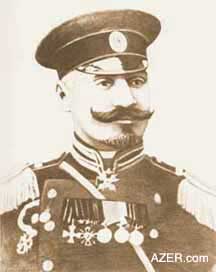  Above: Ali Agha Shikhlinski was known as the "God
of Artillery" in the Russian Army. During the Soviet period,
the truth about his achievements was hidden. Rather, Azerbaijan
was portrayed as never having its own distinguished generals
before Soviet rule. After independence in 1991, it became known
that Shikhlinski was one of the most famous generals of the Tsar's
Russian army and had been honored with the highest military orders
of the Russian Empire-Hero of the Russian-Japanese War in 1905
and Hero of the Russian-German War in 1914. Above: Ali Agha Shikhlinski was known as the "God
of Artillery" in the Russian Army. During the Soviet period,
the truth about his achievements was hidden. Rather, Azerbaijan
was portrayed as never having its own distinguished generals
before Soviet rule. After independence in 1991, it became known
that Shikhlinski was one of the most famous generals of the Tsar's
Russian army and had been honored with the highest military orders
of the Russian Empire-Hero of the Russian-Japanese War in 1905
and Hero of the Russian-German War in 1914.
Shikhlinski wrote textbooks on artillery for the Russian military
academies.
When Azerbaijan gained its independence in 1918, he was appointed
an Assistant of the Defense Ministry. When the Bolsheviks took
control of the country in 1920, Narimanov is credited for saving
Shikhlinski from being killed or imprisoned. Information about
him was removed from historical research and textbooks.
Husein
Javid (1882-1944), another intellectual who was accused of being
a pan-Turkist, was a talented dramatist often called "the
Shakespeare of Azerbaijan". He was arrested in 1937 and
never again seen by his family. He was sent off to a Siberian
labor camp, where he died and was buried. During Perestroika,
in the mid-1980s, his remains were brought to Azerbaijan. Now
a large monument has been raised in his honor in Nakhchivan.
Recently, one of Baku's central avenues was named after him (Husein
Javid Prospect). [See "The Night Father Was Arrested"
by his daughter Turan Javid, in AI 4.1, p. 24, Spring 1996. See
also "Aliyev Memorialized Literary Giant" in AI 4.4,
p. 37, Winter 1996.]
Despite this danger, some Azerbaijani dissidents dared to object.
One of them was Abulfaz Aliyev (1938-2000). More familiarly known
as Elchibey [and later to become Azerbaijan's President from
1992-1993], he taught history at Azerbaijan State University.
He told his students that all Turkic peoples were brothers and
that Russia had conquered Azerbaijan and divided it into two
parts: the northern, which was joined to Russia, and the southern,
which was joined to Iran. As a result, Elchibey was arrested
in the 1970s and imprisoned for two years. After Azerbaijan gained
its independence in 1991, Elchibey was able to actively promote
changes in historical research.
Today, Turkey
is no longer considered to be Azerbaijan's enemy. In 1991, Aydin
Balayev and others wrote about Turkey's important role in helping
the Azerbaijani people survive the genocide by Armenians and
Bolsheviks. From 1918 to 1920, the Turkish Army of General Nuri
Pasha entered Azerbaijan in an attempt to stop the murders of
Azerbaijanis by Armenians. They helped the Azerbaijani government
regain control of Baku and the entire territory of Azerbaijan.
To reveal these facts, many historical documents were analyzed,
including the official documentation of the ADR government, which
had been hidden in secret archives during the Soviet period.
Once Azerbaijanis learned about Turkey's service to their country,
they erected a memorial to honor the Turkish soldiers who had
defended Azerbaijan. The monument, located in Baku's Shahidlar
Khiyabani (Martyr's Alley), was dedicated on October 10, 1998.
The Role of Islam
Since Communism is an atheistic ideology, Soviet historians wrote
that Islam played a negative role in Azerbaijan. "History
of Azerbaijan" states: "Islam, similar to other religions,
taught peasants and poor people in villages to be humble and
peaceful as slaves. This religion declares that the poor people's
dependence on the ruling class is established by God...The Muslim
clergy called for patience and temperance, but themselves gained
great wealth by severely exploiting the poor. The Muslim conquerors
burned Zoroastrian and Christian manuscripts, destroyed churches
and other religious monuments and forced the people to hate all
non-Muslims" (vol. 1, p.108).
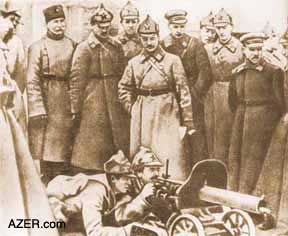  Left: Training of Azerbaijani Soldiers for
the Red Army in 1925 under leadership of the Russian General
Frunze. Left: Training of Azerbaijani Soldiers for
the Red Army in 1925 under leadership of the Russian General
Frunze.
Stalin
prohibited Azerbaijani historians from writing objectively about
Islam. Many of the people who objected were executed or exiled
to Siberia. During the Khrushchev and Brezhnev eras, the Soviet
authorities and the KGB would call any historian who favored
Islam a "Pan-Islamist" or an "anti-Soviet element".
That person would not always be arrested right away. The first
stage was to invite the historian in for what might be called
a "preventive talk". During this conversation, the
KGB authority would say: "You are wrong in your historical
research. Did you forget that you are a Soviet citizen? We forgive
you today, but you have to be reasonable and must not repeat
this mistake. Go home, friend. Starting today, we will be watching
you carefully." A famous historian and friend of mine told
me he had had one such "chat" in 1984.
After such a threatening conversation, most historians were less
vocal, recalling Stalin's Repressions of the 1930s, when hundreds
of thousands of intellectuals and civilians throughout the Soviet
Union were arrested, exiled to Siberia or shot to death. However,
there were some courageous academics in Azerbaijan, like Professor
Rustam Aliyev, a famous researcher of Nizami Ganjavi (1141-1209),
who was called a Pan-Islamist but still continued his research.
After Azerbaijan gained its independence, the situation changed.
Azerbaijani academics were no longer tormented by KGB officials.
Today, you don't find such bitter and unjust criticism of Islam.
As a rule, Islam is described more objectively.
For instance, Professors S. Aliyarli and M. Ismailov write that
Islam united all Azerbaijanis (the Christians in the north and
the Zoroastrians in the south) within the framework of a common
religion and promoted the consolidation of the Azerbaijani nation.
Modern historians also write about the moral and ethical values
that Islam has brought to Azerbaijan. Books about the life and
deeds of the Prophet Muhammad have appeared, as well as various
editions, translations and commentaries on the Koran. The Irshad
Center of Islamic Research has been founded.
 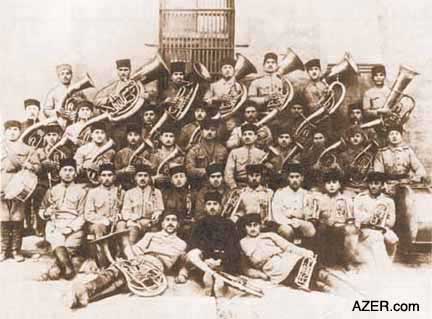
Above:
The government
of the Azerbaijan Democratic Republic (ADR) did have military
forces during its short-lived period of 23 months from May 1918
to April 1920. However, the Bolshevik army proved too powerful
and Azerbaijan lost its independence. Photo shows the military
orchestra of the Azerbaijani Army in Ganja (1918).
Some historical research in modern Azerbaijan is sponsored by
a number of national and foreign Islamic organizations and philanthropic
funds, especially from Iran, Kuwait and Saudi Arabia. Some of
the books that they issue tend to be theological rather than
scientific. Of course, some of these studies are not completely
free of ideology and politics. But this is to be expected in
the climate of religious and political freedom that is now found
in modern Azerbaijan.
Medieval Revolutionaries
In Soviet Azerbaijan, history - even medieval history - was seen in the light of the class
struggle between the poor and the rich. Historians looked for
revolutionary movements of "oppressed people" and compared
them to the Bolshevik Revolution.
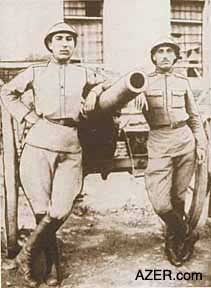  Left: Gunners of the Azerbaijani Army in 1919.
During the Soviet period, historians were not allowed to use
and analyze such photos as they described the Musavat regime.
Soviet history books suggested that the Azerbaijan Democratic
Republic (1918-1920) never had its own regular army and completely
relied on "Turkish occupants". Photos of ADR soldiers
and generals were hidden in various archives. Left: Gunners of the Azerbaijani Army in 1919.
During the Soviet period, historians were not allowed to use
and analyze such photos as they described the Musavat regime.
Soviet history books suggested that the Azerbaijan Democratic
Republic (1918-1920) never had its own regular army and completely
relied on "Turkish occupants". Photos of ADR soldiers
and generals were hidden in various archives.
For
example, we read in "History of Azerbaijan" (vol. 1,
p.90): "In the 5th century AD, the life of people in Azerbaijan
became even harder.Taxes increased and peasants were severely
exploited by the state and landowners.As a result, a great rebellion
of people was raised under the leadership of Mazdak Bamdadan
(5th century AD)...who said: 'It is necessary to deprive the
rich of their property and share it with the poor people'.Even
though 80,000 Mazdakites were killed and the movement was defeated...this
rebellion deeply influenced the further struggle of Azerbaijani
people against the yoke of feudal oppression. In 488 AD he led
a rebellion and advocated an ideology of equality for all people."
Except for its ideological and emotional accents, the information
above is basically correct. However, it's not the whole truth.
Soviet historians purposefully did not mention that most Azerbaijanis
opposed Mazdak because he called for a "community of wives"
and tried to demolish traditional morals. He said that all women
belonged to all men, and that each man could have sexual relations
not only with his own wife, but also with the wives of all other
men.
Eleventh-century writer Nizam al-Mulk severely criticized Mazdak
for declaring: "My followers! Wives are also your common
property. Every woman belongs to each of you, for nobody would
be deprived of the World's pleasures." After the collapse
of the Soviet system, Azerbaijani historians were no longer forced
to idealize Mazdakism and other "revolutionary teachings"
of the Middle Ages. Today it is possible to objectively estimate
their role in history.
Today's Azerbaijani students learn that the military leader Babak
(795 or 798-837) fought for the independence of Azerbaijani people,
not for a class struggle against the rich. He is known for saying,
"It is better to live a single day as a free human being
than 40 years as a slave." Azerbaijanis considered Babak
as a symbol of courage and the struggle for independence. Bolsheviks
tried to capitalize on his popularity and depict him as an "early
Bolshevik".
Independence also allows us to say that early-20th-century Azerbaijani
hero Gachag Nabi (1894-1986) never sympathized with the Bolsheviks
and Marxist-Leninist theory, despite the fact that the Soviets
glorified his struggle against Russian occupation and the oppression
of the Tsarist regime in Azerbaijan.
Medieval Poetry
Soviet historians tried to show great Eastern poets as "strugglers
for the rights of oppressed people." According to "History
of Azerbaijan" (vol. 1, p.165), "The verses by Khagani
Shirvani (1120-1199) reveal with great strength the rebellious
soul of the poet, his angry attack on the tyranny of the ruling
class, the hypocrisy of priests and social injustice." In
fact, Khagani was a traditional Muslim who believed in God and
served as a court poet of the Shirvanshahs. As to the "rebellious
soul" of Khagani, he was a man of difficult character and
often quarreled with relatives and friends, but he never participated
in any social movement.
It's difficult to believe it today, but Soviet historians liked
to criticize medieval poets for their poor understanding and
comprehension of Marxist theory (even though it wasn't even formed
until hundreds of years later). For example, we read in the "History
of Azerbaijan" (vol. 1, p.216): "Nizami Ganjavi (1141-1209)
did not understand the class nature of the feudal state and tried
to influence rulers with his truthful, inspired words; he hoped
to convince them to stop oppressing the people. Nizami also believed
that a ruler who devastated his country should be sentenced to
death." Soviet ideologists tried to show this great thinker
and poet as a cruel revolutionary who longed to shed the blood
of the ruling class. It was not so easy: Nizami was too great
and humane a philosopher.
Historians also took 15th-century poet Imadaddin Nasimi (killed
in 1417) to task for the "pessimistic and naive" character
of his verses: "The legacy of Nasimi is complicated and
contradictory.Sometimes he was doubtful about the victory of
justice. Oppression and bloodshed reigned in the feudal community;
he could not find the inner strength for struggle." Of course,
"History of Azerbaijan" did not describe the rich philosophical
and mystical content of Nasimi's verses, but only that he was
"a pessimist and a mystic." During the Soviet period,
all philosophy that wasn't Marxist-Leninist was considered outdated,
naive and harmful from an ideological point of view. Today, Azerbaijani
poets are talked about as poets, not as naive, early revolutionaries.
Fear of Pan-Turkism
You won't find anything about the Turkic roots of Azerbaijani
people in Soviet history books. Instead, they say that the Turks
conquered Azerbaijan in the 11th-13th centuries, and that the
native residents of Azerbaijan gradually switched from their
ancient languages of Caucasian and Persian origin to a Turkic
language. Azerbaijanis supposedly kept their blood pure and did
not become Turks. Let's open "History of Azerbaijan"
again (vol. 1, p.172): "The same things took place in Central
Asia, where the native languages of Kharezm, Sogdiana, Baktriana
and Parthea were replaced by Turkic languages.Similarly in Azerbaijan
the native languages were substituted with Turkic."
Why were Soviet historians so biased against Turks? Stalin believed
that Turkey would try to unite all of the Turkic nations of the
world under its leadership. More than half of the territory of
the USSR, including Siberia, was inhabited by various Turkic
peoples, so the Soviet leaders considered Pan-Turkism to be a
major threat. To prevent the Turkic peoples from uniting, Stalin
ordered historians to prove that they were completely unrelated
to one another, that all of them had different blood, religions
and traditions. According to Soviet scholars, those peoples who
spoke Turkic languages (for instance, Azerbaijanis, Uzbeks, Turkmen,
and Turks) were Turkic speaking (Turkophone), but not of Turkic
blood.
Beginning in 1937, the huge machine of Soviet propaganda, including
history books, novels, newspapers, radio, schools and universities,
spread these ideas. To be arrested as a Pan-Turkist, one had
only to say "Turkic people" instead of "Azerbaijani
people". Even the seventh-century Azerbaijani epic "Dada
Gorgud" (The Book of my Father Gorgud) was forbidden because
it was branded as Pan-Turkist literature.
Now that Azerbaijan is independent, Azerbaijanis may freely speak
about their Turkic roots. Documents of the Azerbaijan Democratic
Republic that have now been published show that Azerbaijanis
once officially called themselves Turks. For example, the chairman
of the Azerbaijani Parliament, Hasan-bey Aghayev, said during
the celebration of the first year of independence in 1919: "The
Turkic people gained freedom by their blood and will never give
up this freedom.A free Azerbaijan is an ideal that lives in the
hearts of all Turkic people, from intellectuals to workers and
peasants."
The debate about the role of Turkic tribes in Azerbaijan's history
continues to this day. Some extreme researchers, so-called "historian-patriots",
have even started to exaggerate the role of the Turks and completely
deny the role of other nations, such as the Arabs, Persians and
Caucasian tribes. Perhaps this is only a temporary tendency.
Each historian has a right to his or her own opinion, but ideological
blinders should not prevent us from seeing the real facts.
Georgia as Ally
If you open any Soviet history book, you will read that Azerbaijanis,
Armenians and Georgians are brothers who have always struggled
together against Persians, Arabs and Turks. According to Soviet
historians, the Caucasus is like a little island surrounded by
the huge ocean of the terrible Muslim world. For example, we
read in "History of Azerbaijan" (vol. 1, p.120): "The
hero of Azerbaijan, Babak, set up relations with Armenians who
raised a rebellion. Babak helped the Armenians and overcame the
Arabic troops near Sunik.The struggle of the Azerbaijanis, Georgians
and Armenians against the Arabs continued even after the death
of Babak.Peoples of these countries fought heroically against
the enemy."
In this way, history books suggested that the Caucasian peoples
of the USSR (Armenians, Georgians, as well as Lezgins and Tats)
were closer to Azerbaijanis than the Arabs, Persians and Turks
were. Now that Azerbaijan is independent, history has become
more objective. The Caucasian friendship is not disclaimed. Yet,
Azerbaijan is not a typical Caucasian state - geographically,
ethnically or linguistically. Azerbaijan's scope has always extended
beyond the Caucasus. Southern Azerbaijan is situated in Iran.
The ethnic brothers of Azerbaijanis (such as the Turks, Turkmens
and Uzbeks) also live outside the Caucasus in the waste territories
of Eurasia.
Modern historical texts do stress that Georgia was a traditional
ally of Azerbaijan. For example, in 1991, Aydin Balayev wrote
that Georgia was a military ally of Azerbaijan during the ADR
period of 1918-1920. This fact was never mentioned during the
Soviet period. Besides, historians have noted that during the
Middle Ages, Georgia was an ally of the Shirvanshahs in Northern
Azerbaijan. The Shirvanshahs and Georgian rulers often intermarried
and struggled together against various invaders.
Azerbaijani historians are also exposing some negative facts
about Azerbaijan's relationship with Georgia. For example, in
the 12th century, after the earthquake in Ganja, Georgians attacked
and completely destroyed the city. The Azerbaijanis who had survived
the earthquake were either killed or taken as slaves. During
the Soviet period, only academician Ziya Bunyadov dared mention
this fact; most other historians were afraid and kept silent.
Conflicts - Armenia
Even though official Soviet ideology tried to depict Armenians
and Azerbaijanis as friends, some Armenian historians wrote that
the Azerbaijani state had never existed and that almost all of
Azerbaijan was really part of Armenia. They issued maps of historical
Armenia, showing that their country included all of Azerbaijan's
territories.
During the Soviet period, most Azerbaijani historians were afraid
to object to the Armenians because they were protected by the
Soviet regime. But the Azerbaijani people were very upset that
our historians and professors kept quiet. I remember well that
atmosphere of anger.
The bravest Azerbaijani dissident to oppose the Armenians was
Professor Ziya Bunyadov (1923-1997), a huge figure in the study
of Azerbaijani history. In his book "Azerbaijan in the 7th-9th
Centuries AD", Bunyadov proved that no part of Azerbaijan
was considered part of Armenia in ancient times. He also wrote
about the independent Azerbaijani states of Shirvan and Aran
(Caucasian Albania), which covered the territory of Northern
Azerbaijan and some other territories. Many Armenian historians
were enraged by Bunyadov's books, calling him a "chauvinist"
and the "No. 1 Enemy" of Armenia.
But Bunyadov was not a chauvinist. His mother had Russian blood,
he spoke Russian fluently and knew some Armenian and Georgian
as well. He liked the Georgian people and sometimes even used
to wear the national Georgian hat. Bunyadov had many friends
among Russians, Georgians and even Armenians, and never criticized
Armenians or any another nation for its ethnic origin. He simply
wrote the history of Azerbaijan and tried to write it correctly.
Bunyadov could dare to do this because he was decorated as a
hero of World War II and had been honored with the highest military
orders of the USSR. In addition, he was very famous in the academic
world. Brezhnev was not as vicious as Stalin - he didn't want the entire world to
talk about a repression against famous intellectuals in the USSR.
Less distinguished historians, such as Abulfaz Aliyev [Elchibey],
could be arrested, but academicians generally were not touched.
Ironically, Bunyadov's death came at the hands of terrorists
in independent, democratic Azerbaijan - after the collapse of the USSR, when
he was entering his own apartment complex on the way home from
Parliament. The Azerbaijani courts have declared that they have
found and convicted the killers, who are now in prison.
Another contemporary scientist who has dared to object to the
Armenians is Farida Mammadova, the author of "The Political
History and Historical Geography of Caucasian Albania."
Mammadova proved that from the 4th century BC until the 7th century
AD, Caucasian Albania (modern Northern Azerbaijan) was an independent
state and never part of "Greater Armenia". Russian
and Armenian scholars criticized Mammadova, but her work has
been highly valued by European scholars. After Azerbaijan became
independent, her doctoral work was also approved by the High
Attestation Commission in Baku.
Now that Azerbaijani historians have the freedom to write about
controversial historical events, the heated arguments between
Azerbaijani and Armenian historians continue. For the first time,
Azerbaijani historians are writing about the thousands of Azerbaijanis
who were killed by Armenians in Baku and other places in Azerbaijan
in 1918. Suleyman Aliyarov and Bakhtiyar Vahabzade (1925- ) have
written about the deportation and genocide of hundreds of thousands
of Azerbaijanis in Armenia during the 19th century.
Now that old documents and maps from Azerbaijan's archives are
being published, we are learning about historical facts that
were kept hidden for decades. For instance, a map prepared by
the government of the ADR was released from the secret archives
in 1990. This map had been prepared in 1920 by the Ministry of
Foreign Affairs, showing that the ADR in those times included
all of the territories of the modern Azerbaijan Republic, plus
Zangezur, which is now part of Armenia. This province, which
was populated mainly by Azerbaijanis and Kurds, was given to
Armenia after the establishment of Soviet rule in Azerbaijan
in the 1920s.
In 1919, Armenia issued its own map, which didn't represent reality,
but rather expressed the territorial claims of the Armenian Dashnak
government. On this map, Armenia is shown as including the Azerbaijani
territories of Nakhchivan and Karabakh (and Zangezur, of course),
the Georgian provinces of Akhalkalak and Borchali as well as
the Turkish Kars.
In reality, these territories never belonged to the Republic
of Armenia. In 1919-1920, Armenia was at war with Azerbaijan,
Georgia and Turkey. In 1919, a military pact between the ADR
and Georgia was signed, and Azerbaijan helped Georgia with weapons.
As a result, Armenia could not capture Akhalkalak in Georgia
and was stopped in Karabakh. In turn, Turkish troops moved into
Armenia and forced it to capitulate. Only the invasion of the
Bolshevik Red Army in 1920 helped Armenia save its territory
and sovereignty.
Joining Russia
Soviet historians were forced to stress the "great historical
importance" of joining to Russia. They stated that in the
18th century, Azerbaijan was devastated by the Iranian army,
and khanates sent messages to the Russian tsar asking him to
join Azerbaijan to Russia. So the Russian army came, defeated
Iran and rescued the Azerbaijani people. As a result of the Gulistan
(1813) and Turkmanchay (1828) treaties, Azerbaijan was divided
into Northern (Russian) Azerbaijan and Southern (Iranian) Azerbaijan.
In the second volume of "History of Azerbaijan" (1960,
p.47) we read: "The joining of Azerbaijan to Russia rescued
the Azerbaijani people from the danger of enslavement by the
backward Iran and Turkey.Even though Russia was ruled in those
times by the despotic tsar and landowners...joining to Russia
promoted the political, economic and cultural development of
Azerbaijan."
The words of Nariman Narimanov (1870-1925) were quoted so often
that they became a slogan: "The eternal happiness of Azerbaijan
is associated with Russia!" Narimanov was Chairman of the
Central Executive Committee of the Russian Communist Party in
1925.
Azerbaijani historians also quoted Mirza Fatali Akhundov (1812-1878),
who wrote: "Owing to the patronage of the Russian state,
we were rescued from endless invasions and the robbery of conquerors
and found peace at last." Of course, this was not the opinion
of all Azerbaijani people; Narimanov was a Communist and Akhundov
had been a Russian military officer.
Soviet authorities persecuted those who did not agree with the
idea that "the eternal happiness of Azerbaijan is associated
with Russia." Famous academician Heydar Huseynov did not
agree. He studied the anti-Russian movement of Sheikh Shamil
(1798-1871) in the North Caucasus and revealed the crimes of
the Russian army during this war. Tragically, the academician
later hung himself in his countryside home. In the post-Stalin
period, the Soviets avoided arresting famous dissidents, but
perhaps there were other ways to get rid of them. Not all professors
were like Ziya Bunyadov, who was strong enough to bear the psychological
pressure of the Soviet system.
Now Azerbaijani historians may write the truth about the so-called
"voluntary joining" of Azerbaijan to Russia. Even schoolchildren
now know that Azerbaijan was conquered by Russia and did not
choose to be under its rule.
History textbooks now tell about the Azerbaijani people's resistance
to Russia's aggression. For example, in 1803, Javad khan, the
ruler of the Ganja khanate, refused to let the Russian army,
commanded by General Tsitsianov, into his city. In response to
the General's threats, he said: "Your guns are long, but
my guns are longer!" The khan and his warriors were killed
on the walls of Ganja while fighting against the Russian troops.
In 1804, Huseyn Gulu khan of Baku suddenly attacked the Russian
military detachment, defeated it and killed General Tsitsianov.
In 1806, Salim khan of Shaki raised a rebellion against the Russians.
His tiny army was defeated, but the people of Shaki continued
to resist. They surrounded the walls of the city with fuel and
burned it when the Russian soldiers tried to climb up. Even though
Shaki was captured, rebellions were sparked in Talish and other
khanates. On the basis of these and other facts, modern historians
in Azerbaijan have proved that "joining" Russia was
hardly voluntary.
However, the question about Russia's role in the history of Azerbaijan
is still not completely settled. Some historians still believe
that Russia played a positive role, saying: "In the 18th
and 19th centuries, the Azerbaijani khanates were too weak. We
would have been annexed by Iran if Russia had not conquered us.
It was better to be ruled by Russia than Iran. Through the Russian
influence, we were able to adopt European culture and develop
our national intellectuals such as Akhundov, Bakikhanov, Sabir
and Mammad Amin Rasulzade. If all of Azerbaijan (Southern and
Northern) had remained under Iranian rule, we would gradually
have been assimilated."
Their opponents argue that Russia separated Azerbaijanis from
their traditional way of life and religion and forced them to
follow Russian customs. They also maintain that the Russians
severely exploited Azerbaijan's natural resources without proper
compensation.
Coming of Bolsheviks
Soviet historians also painted a skewed picture of the revolutionary
movement in Azerbaijan during the late 19th century and early
20th century. According to "History of Azerbaijan"
(vol. 1, p.297): "The worker movement in Azerbaijan began
in the 1870s and 1880s as a part of the struggle of the Russian
worker class." Soviet books describe a succession of economic
strikes and meetings that took place in Baku and other cities
in Azerbaijan. About 1,000 pages of the second volume of "History
of Azerbaijan" are devoted to this era, whereas the first
volume, which is devoted to the ancient and medieval period,
contains fewer than 400 pages!
After independence, Azerbaijani historians found out that in
the early 1900s, more than 90 percent of the Socialists and Bolsheviks
in Baku were Russians, Armenians and peoples of other nationalities,
not Azerbaijanis. To attract more Azerbaijanis to the movement,
the Russian Social-Democratic Party founded a special branch
of the party (Hummat) for the Muslim workers. Soviet historians
exaggerated the role of Hummat in Azerbaijan. Modern research
has proven that this terrorist organization, financed by the
Russian Bolsheviks, was actually not very popular among Azerbaijani
workers.
Much of the recent historical research in Azerbaijan has been
devoted to learning more about the Musavat Party, Azerbaijan's
first major political party, which was founded in 1911. Soviet
leaders tried to hide the facts about the Musavat Party and its
leaders, so books written by Mammad Amin Rasulzade (1884-1955),
the leader of the Party, were prohibited. After Azerbaijan gained
its independence, these books and articles by Rasulzade were
issued, revealing a real treasury of political thought. For 70
years, Azerbaijani readers were deprived of the right to read
books by the founder of independent Azerbaijan.
Now we have learned the truth about the collaboration between
Bolsheviks and Armenian nationalists in Baku. For example, the
official documents and newspapers of those times inform us that
in 1918, Bolsheviks and Dashnaks killed several thousand Azerbaijani
civilians in Baku, including elderly persons, women and children.
These facts were hidden during the Soviet period.
Soviet historians praised the 26 Baku Commissars as "internationalists"
and denounced the legitimate government leaders of the Azerbaijan
Democratic Republic as "chauvinists". Modern publications
reveal that the Musavat Party and the Azerbaijani government
were never chauvinists. Just consider the composition of the
Azerbaijani Parliament in 1918. About 30 percent of the members
were national minorities: there were 7 Armenian Dashnaks, 7 Armenians,
7 Russians and 13 Bolsheviks. There were also Jews, Germans,
Poles, Lezgins, Tats, and Georgians. In regard to the 26 Baku
Commissars, who Azerbaijanis view as traitors to their country,
only two of them - Azizbekov and Vazirov - were Azerbaijanis.
Soviet books also lie about the collapse of the Democratic Republic
in 1920, when the Red Army occupied Azerbaijan. They write that
the workers in Baku raised a rebellion and asked the Russians
to help them. As a result, the Musavat government was overthrown
by the Azerbaijani Bolsheviks with the help of their brothers,
the Great Russian People. Actually, the Russian troops were already
in Baku when the Azerbaijani Bolsheviks decided to forward their
letter to Moscow asking for military help.
With this message, they only wanted to show that the Azerbaijani
government was overthrown not by foreigners, but by the Azerbaijani
people themselves. However, the Azerbaijani Parliament had already
been occupied by the Bolsheviks on April 27, not on April 29
when the letter was sent to Moscow. Soviet historians tried to
hide this fact.
Consider also that the Azerbaijani army only had about 20,000
soldiers, and not many weapons. Russia, on the other hand, had
the ability to send several hundred thousand soldiers into Azerbaijan.
Nevertheless, Azerbaijani generals like Mehmandarov (1856-1931)
and Shikhlinski (1863-1943) were not afraid; they were ready
to fight against Russia. But the Azerbaijani Parliament, at the
request of Turkey, decided not to show resistance, and the Azerbaijani
army was forced to fulfill the
government's decision.
In today's climate of independence, our historians may now analyze
why the Azerbaijani army did not resist the Bolsheviks. In fact,
the Azerbaijani government knew that their tiny national army
would not be able to stop the invasion of the huge Red Army.
Also, Turkey, Azerbaijan's closest ally, had decided to include
the Caucasus in the Russian sphere of influence. Ataturk, the
Turkish leader, needed Russia's help in his struggle against
the European countries. In turn, Russia promised to help Turkey
with weapons. Therefore, Turkey refused to help the Azerbaijan
Republic against Russia. Furthermore, the Turks asked Azerbaijan
not to show resistance to the Red Army, because this army was
coming to help the Turkish people. It was under these conditions
that the Musavat government left its post to prevent bloodshed
in Azerbaijan.
Nor did Soviet historians ever mention the conditions under which
the Musavat Parliament agreed to transfer power to the Bolsheviks:
(1) The Russian army will not enter Baku but will go directly
to Turkey to help Ataturk, (2) the independence and territorial
integrity of Azerbaijan will be secured, (3) the Azerbaijani
army will be preserved, (4) political freedom for all political
parties will be ensured, (5) the former governmental authorities
will not be victimized and employees will not be discharged,
and (6) the final form of political system in Azerbaijan will
be appointed by the High Legislative Organ, which shall be newly
elected in the democratic way. Of course, all of these promises
were immediately broken by the Bolsheviks.
Communist Leaders
During the Soviet period, historians apologized for Communist
leaders like Kirov, Shaumian and Azizbekov. The cult of Stalin
was demolished after his death in 1953. Mirjafar Baghirov, the
Communist leader of Azerbaijan during the Stalinist period, was
executed as a "people's enemy". Soviet historians found
that they could criticize certain leaders like Stalin, Beriya
or Baghirov, or historical periods like the Stalinist era, but
they never dared criticize the Soviet system, Marxist ideology
or the cult of Vladimir Lenin. These were holy things for Soviet
ideology and history.
New information about Nariman Narimanov (1870-1925), the first
Communist leader of Azerbaijan, began to appear in historical
works. His unpublished letter to Radek (the Communist leader)
was edited for the first time during Perestroika. It turns out
that Narimanov was against the chauvinistic politics of the Russian
authorities in Azerbaijan. He sent letters to Moscow complaining
about Russian emissaries who infringed upon the rights and interests
of the Azerbaijan Republic, used Azerbaijani oil and other natural
resources without paying and offended national employees.
Narimanov was a very famous figure who was sometimes called the
"Lenin of the East". He tried to lead an independent
policy in Azerbaijan. Lenin himself was very sick during this
period and Stalin was not yet very strong. Narimanov was invited
to Moscow and appointed to a higher governmental post in the
Soviet Union. He became one of several members of the Central
Executive Committee. After a short time, in 1925, he suddenly
died of a heart attack. Sergey Kirov was sent from Moscow to
replace Narimanov as the leader of Azerbaijan.
After Soviet Perestroika (which began in 1985) and Independence,
the lists of Azerbaijani intellectuals who were imprisoned and
executed during the Stalinist Repression (1937-38) were published
in the newspapers. The KGB of Azerbaijan was transformed into
the Ministry of National Security (MNS), which says it wants
to reveal all of the crimes of the Stalinist period. The names
that were published included scholars like Vali Khuluflu and
Salman Mumtaz and poets like Mikayil Mushvig and Huseyn Javid.
The names of killers from the NKVD - Narodni Kommisariat Vnutrenikh
Del (The People's Ministry of Internal Affairs), the forerunner
to the KGB during the Stalinist period - were also revealed, including Grigorian,
Markarian, Topuridze and Atakishiyev.
The NKVD assassins all worked under the supervision of Mirjafar
Baghirov, who ordered them to kill the best representatives of
the Azerbaijani people. Baghirov's last words at his trial were
published as well. He said: "Yes, I am guilty, but if I
am the only guilty one, it is insufficient to shoot me, it is
necessary to cut me into a thousand pieces." Baghirov wanted
to say that thousands of other Soviet authorities and the Soviet
system as a whole were guilty as well, but they were not punished
at that time.
After Azerbaijan gained its independence, some new historical
works about Baghirov were published, characterizing him as a
bloody tyrant who used to beat and kill arrested individuals
in his own office.
However, Baghirov did some positive things as well. For example,
before World War II, Stalin wanted to round up all of the Azerbaijani
people and resettle them in Central Asia. He was afraid that
the Azerbaijanis would help neighboring Turkey, the ally of Germany
at that time. Baghirov called Stalin and said: "Comrade
Stalin! Don't do it. I promise that you will not have problems
with these people."
"Are you ready to be responsible?" asked Stalin after
a long pause.
"Yes," replied Baghirov. As a result, Azerbaijanis
were not dislocated.
We have also recently learned about another episode that was
kept secret during the Soviet period. Armenian leader Arutinov
sent a message to Stalin saying that he wanted Nagorno-Karabakh
to be joined to Armenia. In turn, Stalin sent this message to
Baghirov and asked for his opinion. Baghirov replied that he
was ready for this to happen, but first, Armenia should cede
Zangezur to Azerbaijan and give autonomy for Azerbaijanis in
the remaining territory of Armenia. Arutinov did not agree, so
Karabakh remained in Azerbaijan.
Repression
Even famous Azerbaijani geneticists were tormented by the KGB
during the Stalinist period. Genetics was considered a "capitalist
science" and all geneticists were declared "enemies
of the people". The founders of genetics - Johann Gregor Mendel, Thomas Hunt
Morgan and August Weisman - were declared "agents of capitalism".
Newspapers have revealed that the famous Azerbaijani geneticist,
professor Mirali Akhundov, jumped out of his window when the
KGB authorities came knocking at his door. For a long time, he
hid himself in a mountainous village near Shaki.
After Azerbaijan became independent, many scientists came forward
to tell the truth about the Stalinist Repression. My grandfather,
professor Aghakhan Aghabeyli, was a geneticist who published
a genetics textbook in the 1930s and therefore was invited to
the KGB.
"Are you a Mendelist?" the KGB officer grilled him.
"I am a geneticist," he replied.
"So, are you a Morganist or a Weismanist?" the officer
demanded angrily.
"As I already said, I am a geneticist and nothing more,"
he replied again.
"Well," the officer said suddenly. "Go home. We
will call you tomorrow."
My grandfather feared the KGB. He and his family lost a lot of
sleep worrying that he would be arrested or executed. He even
prepared a small bag with some clothes and necessities in case
he was taken away. Fortunately, the KGB never called again. Maybe
they were simply trying to frighten him, or perhaps they just
forgot about him. Who knows?
Rewriting History
As soon as Azerbaijan gained its independence 10 years ago, Azerbaijanis
began re-exploring their history. We have found that so many
facts were confused, hidden or changed by Soviet propaganda that
it has been difficult to clear up all of the details. Many items
remain unclear and questionable.
Azerbaijanis have a right to know what really happened. But what
is the truth, and how do we write an objective history? Even
though Azerbaijani history textbooks are already being rewritten,
there is still controversy over certain areas of history.
For instance, there are bitter arguments going on amongst the
Azerbaijani scientists who study ancient history. Some of them,
such as academician Igrar Aliyev, believe that Azerbaijanis in
ancient times (more than 1,500 years ago) spoke ancient languages
of Caucasian and Iranian origin, but not Turkic. Other scientists
believe that Azerbaijanis have almost always spoken a Turkic
language. Some of them suggest that ancient peoples such as the
Medeans, Sumerians, Caucasian Albanians and others were Turks
and that the Near East is an ancient motherland of Turkic tribes.
The antagonism between these two sides rages on. I say "antagonism"
rather than "debate" because, unfortunately, the culture
of debate does not yet exist in Azerbaijan. Under Soviet rule,
we were never allowed to carry on debates about official history.
The official slogan was: "A person who does not agree with
us is our enemy."
Unfortunately, we have yet to rid ourselves completely of that
Bolshevik psychology. Instead of normal scientific discussion,
there is antagonism and name-calling. Some scientists, especially
from the older generation, blame others and call them "predators",
or even accuse them of being Russian, Turkish, Persian or Armenian
spies! Because of this, some of the younger scientists are afraid
to express their own views on questionable topics because they
don't want to be targeted.
In addition, one should not forget that many of the historians
who are now in high-ranking positions were once members of the
Communist Party and cannot be expected to be completely objective.
If they criticize the Soviet system, they would also be incriminating
themselves. Therefore, most of them prefer to remain silent about
these events.
Today there is a trend among some of our scholars to idealize
the Soviet period. Ramiz Akhmadov, the leader of the modern Azerbaijan
Communist party, says: "Before Soviet rule, almost all Azerbaijanis
were illiterate and did not have their own universities. There
were few physicians, teachers and scientists in pre-Soviet Azerbaijan.
Thanks to the Bolsheviks, almost all of our people became literate,
scores of universities and academies were founded, medical care
became free of charge and people became sufficiently well off.
You couldn't find a homeless or jobless person in all of Azerbaijan.
And what about today? Many Azerbaijanis have become poor and
illiterate again!"
His opponents, the historians who ascribe to democratic ideology,
usually say: "But all of this success was achieved through
bloody repressions and the infringement of human rights. The
best intellectuals were shot. We were deprived of our religion,
our alphabet and our traditions. During the Brezhnev period,
the morals of the people deteriorated, and corruption spread
throughout all layers. Our products were cheap but of inferior
quality, and our medical care was poor. Today, we are a free
nation. As for recent hardships, they are temporary."
I believe that someday a comprehensive, objective, non-ideological
history of Azerbaijan will be written, but not today. The possibility
is there, but it will take time to sift through all of the material
and cultivate a culture of calm, rational scientific debate.
Science must be free of ideology.
Farid Alakbarov,
a frequent contributor to Azerbaijan International, has worked
at Baku's Institute of Manuscripts since 1987. He is now chief
scientific officer for the Department of Arabic Manuscripts at
the Institute. He holds a Doctorate of Sciences in History (1998)
and a Candidate of Sciences in Biology (1992).
For more information about Baku's Institute of Manuscripts, see
"Voices
from the Ages," in AI 8.2 (Summer 2000). To read other articles
by Alakbarov, SEARCH at AZER.com. Many of his articles are also
available in Azeri (Latin script) at AZERI.org.
____
From Azerbaijan
International
(9.3) Autumn 2001.
© Azerbaijan International 2001. All rights reserved.
Back to Index
AI 9.3 (Autumn 2001)
AI Home
| Magazine
Choice
| Topics
| AI Store | Contact us
Other Web sites
created by Azerbaijan International
AZgallery.org | AZERI.org | HAJIBEYOV.com
|











